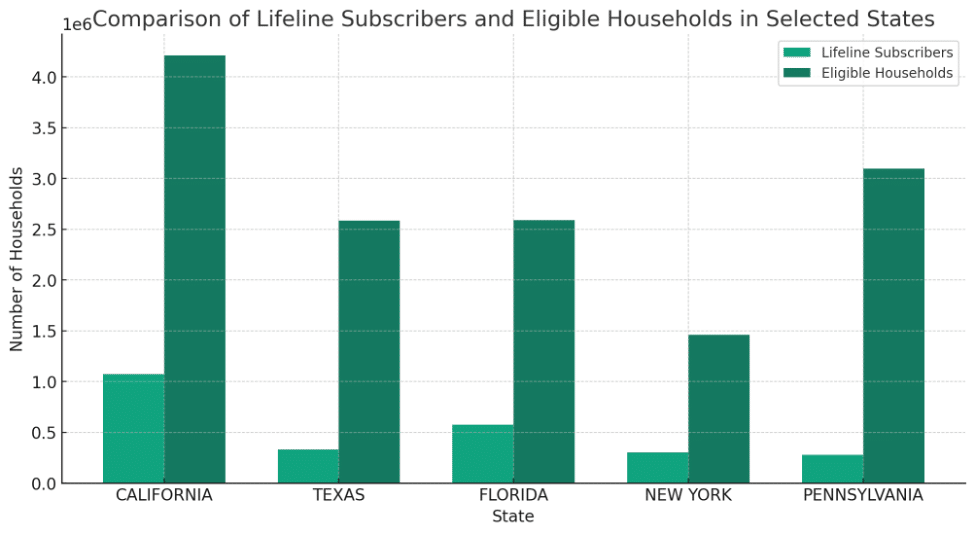The Lifeline program helps make phone and internet services more affordable for low-income individuals. It offers discounts on phone or internet services to eligible subscribers, helping to ensure that all Americans have the opportunity to access essential communications for work, education, and personal safety.
Lifeline has helped millions of Americans facing financial hardships, including seniors, disabled individuals, and low-income families.
Let’s take a look at a few real-life experiences. Please note that the names and other details have been changed to protect privacy.
Sarah’s Story
Sarah Thompson, a single mother living in a small Ohio town, faced a daunting challenge when the factory she worked at shut down. With two young kids, Emily and Jack, and limited job options, she felt overwhelmed. “Losing my job was tough. It was hard to see a way forward,” Sarah remembered.
It was the FCC’s Lifeline program that offered her a glimmer of hope. Lifeline provides discounted phone or internet services to eligible low-income subscribers, ensuring essential communication access. “Discovering Lifeline was a turning point for us. It kept us connected when it mattered most,” Sarah shared. This support was instrumental in her job search and keeping in touch with her children’s school.

While Lifeline provided vital assistance for phone services, Sarah also learned about the Affordable Connectivity Program (ACP), a program that supplements Lifeline by offering additional support for phone and internet services. “ACP was a helpful bonus, giving us that extra support for our internet needs,” she says. This was especially beneficial for her children’s online schooling during the pandemic.
With Lifeline’s assistance, Sarah managed to secure a new job, and her children continued their education without disruption. “Lifeline was our lifeline. It wasn’t just about the phone or internet. It was about staying a part of the community, finding new opportunities, and giving my kids a sense of stability,” Sarah reflected.
Sarah’s story is a testament to the impact of Lifeline in bridging communication gaps for those in challenging financial situations. Her experience highlights how essential programs like Lifeline are in providing more than just a service – they offer a connection to a wider world of opportunities and a path forward during difficult times.
George and Helen’s Story
George and Helen Williams, a retired couple in their late seventies, lived in a small rural community in Virginia. They cherished a simple life, surrounded by memories and the tranquility of nature. However, as they aged, they found themselves increasingly disconnected from the rapidly evolving world outside their cozy home. “We felt like the world was moving on without us,” George said, his voice tinged with a sense of loss.
Their grown children, busy with their lives in distant cities, worried about their parents’ isolation and safety. Helen had been struggling with her health, and their nearest hospital was miles away. “Every time I had a health scare, I feared we couldn’t get help in time,” Helen recounted, recalling the anxiety that clouded their days.
The turning point came when their neighbor told them about the Lifeline program, a federal initiative offering discounted phone and internet services to eligible low-income subscribers. “Learning about Lifeline was like finding a lifeline,” George recalled, his eyes lighting up. With the help of Lifeline, they could afford a reliable phone service, ensuring they could contact emergency services if needed and stay in touch with their family.
Embracing this new change, George and Helen discovered the joys of video calls with their grandchildren, reconnecting with friends, and even exploring new hobbies online. “Seeing our grandkids’ faces on the screen, sharing stories, it brought so much joy into our lives,” Helen said, smiling at the memory. George found a new interest in online gardening forums, exchanging tips and tricks with fellow enthusiasts.
Their story also touches on the Affordable Connectivity Program (ACP), which complements Lifeline by providing further assistance for internet services. “With ACP, we ventured into the digital world. It was daunting at first, but it opened new doors for us,” George remarked. The internet not only became a source of entertainment but also a gateway to essential services and information.
Now, George and Helen no longer feel left behind by the digital age. They have embraced technology as a vital part of their daily lives, enriching their golden years. “Lifeline didn’t just connect us to our family and the world; it restored our sense of belonging and adventure,” Helen said, her voice full of gratitude.
George and Helen’s experience is a heartwarming reminder of how programs like Lifeline and ACP can transform lives, breaking down barriers of age and distance, and bringing the world closer to those who once felt left behind.
* Please note: Names and other details have been changed to protect privacy.
Who Uses the Lifeline Benefit Program?
The Lifeline program helps people who don’t have a lot of money pay for phone and internet services. It’s a program in the United States that started to make sure everyone can connect with others, find jobs, get health care, and stay safe.
The government helps by paying part of the phone or internet bill each month, which makes it easier for families and individuals to stay connected.
Average Lifeline Payment
The Lifeline program helps by giving a monthly discount on phone or internet bills. To understand how much this discount is, we look at the average Lifeline payment. This amount can change based on where you live and the service you choose.
👉 Average Amounts: Lifeline provides up to a $9.25 monthly discount on service for eligible low-income subscribers and up to $34.25 per month for eligible subscribers on Tribal lands.
These payments can vary but are typically $9.25 per month for eligible subscribers. This helps make phone and internet services more affordable.
How Do People Qualify for Lifeline?
If you look at the data, it turns out that most people who participate in the Lifeline program qualified because they were already receiving assistance from another program.
Let’s look at which programs help people qualify for Lifeline. As you can see, most Lifeline participants were eligible because they already qualified for other types of assistance.
| Qualifying Program | Percentage of Lifeline Subscribers |
| Medicaid | 43.89% |
| State Assistance Programs | 21.61% |
| SNAP | 11.41% |
| Income-based Eligibility | 3.13% |
As you can see, nearly half of all Lifeline participants joined the program because they received Medicaid benefits. This goes to show the importance of exploring your options if you are approved for financial assistance. You probably already qualify for several other helpful programs!
Lifeline Participation by State
Let’s look at how many people use the Lifeline program in different states. We can see how many people are signed up for Lifeline in each state and how many households could sign up based on their income.
Here’s a table showing which states with the highest participation rates in the Lifeline program:
| State | Subscribers | Participation Rate |
| Puerto Rico | 531,736 | 65% |
| Oklahoma | 154,388 | 32% |
| District of Columbia | 29,664 | 32% |
| Alaska | 20,719 | 28% |
| Georgia | 304,167 | 27% |
| Louisiana | 183,516 | 26% |
| California | 1,074,827 | 26% |
| Mississippi | 105,278 | 26% |
| Kentucky | 148,889 | 24% |
| Ohio | 321,994 | 23% |
| Michigan | 287,017 | 23% |
| West Virginia | 58,697 | 22% |
| Indiana | 159,661 | 22% |
| New York | 576,484 | 22% |
| Arizona | 176,873 | 22% |
| Nevada | 82,799 | 22% |
| New Mexico | 69,350 | 21% |
| Pennsylvania | 303,064 | 21% |
| Arkansas | 80,740 | 20% |
| Maryland | 124,419 | 20% |
| South Carolina | 113,168 | 20% |
| Tennessee | 166,475 | 20% |
| Rhode Island | 17,334 | 20% |
| North Carolina | 222,003 | 19% |
| Illinois | 344,782 | 19% |
| Florida | 442,890 | 19% |
| Massachusetts | 111,998 | 18% |
| Delaware | 16,287 | 18% |
| Connecticut | 39,582 | 17% |
| New Jersey | 135,362 | 17% |
| Alabama | 105,050 | 17% |
| Missouri | 122,858 | 17% |
| Colorado | 59,343 | 17% |
| Washington | 91,481 | 13% |
| Minnesota | 69,812 | 14% |
| Iowa | 31,233 | 14% |
| Wisconsin | 72,752 | 15% |
| Virginia | 104,628 | 16% |
| Maine | 20,481 | 12% |
| Utah | 27,066 | 12% |
| Vermont | 8,010 | 10% |
| New Hampshire | 9,175 | 9% |
| Texas | 276,500 | 9% |
| South Dakota | 6,149 | 8% |
| Hawaii | 10,782 | 8% |
| Idaho | 13,806 | 7% |
| Nebraska | 6,320 | 3% |
| Oregon | 17,025 | 3% |
| Montana | 3,205 | 3% |
| Wyoming | 787 | 1% |
State-Specific Analysis
For a more detailed understanding, we can look at how the Lifeline program is used in specific states. The following graph presents data for five states: California, Texas, Florida, New York, and Pennsylvania. It shows the number of current Lifeline subscribers versus the total number of households that are eligible based on income.
Comparison of Lifeline Subscribers and Eligible Households in Selected States

As you can see, the graph shows that many more people could be taking advantage of this valuable Lifeline benefit. All they need to do is apply.
The differences in Lifeline participation rates and benefits across states can be due to various factors. These might include the level of public awareness about the program, the ease of applying, and differences in how states administer the program. For instance, states with more outreach and simpler application processes typically see higher participation rates.
Join Millions of Americans – Sign Up for Lifeline Today!
If you’re considering the Lifeline program, know that you are not alone. Millions of Americans are already benefiting from this valuable assistance, staying connected with the world around them. Whether it’s for staying in touch with loved ones, accessing vital services, or seeking opportunities, Lifeline is there to help bridge the gap.
Our analysis shows that in states across the country, from California to New York, a significant number of households are taking advantage of Lifeline. There’s no doubt about it – the Lifeline program is a big success. It helps millions of people access phone and internet services to stay in touch with loved ones, find jobs, and get important information.
Remember, help is available. You have the opportunity to join millions of other Americans in getting connected. The benefits of Lifeline can make a real difference in your daily life. It’s important to explore this option and apply if you’re eligible. By doing so, you’re taking a positive step towards staying connected and empowered in our digital world.